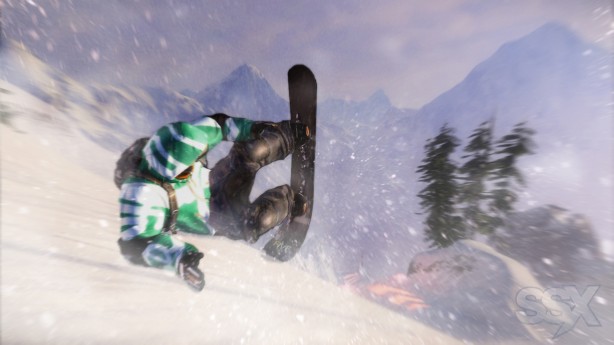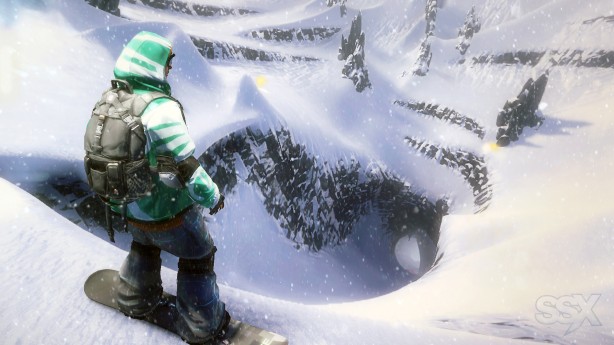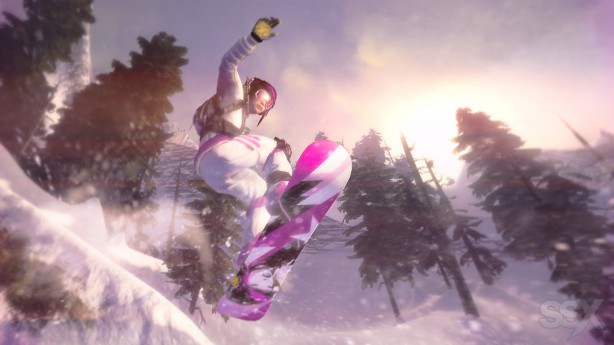SSX Preview
 SSX, despite all of its many plaudits, is still one of the most underrated game series ever made. The original game took the PlayStation 2 by the throat at launch, forcing it to produce panoramic vistas, staggering special effects and some of the biggest open-ended levels players had ever seen. The development team at EA were giving players the unique experiences that define new consoles, and SSX was the vehicle.
SSX, despite all of its many plaudits, is still one of the most underrated game series ever made. The original game took the PlayStation 2 by the throat at launch, forcing it to produce panoramic vistas, staggering special effects and some of the biggest open-ended levels players had ever seen. The development team at EA were giving players the unique experiences that define new consoles, and SSX was the vehicle.
Or snowboard.
So now here we are, with a new SSX due to arrive on a new generation of consoles. The series is easily one of the top extreme sports titles in gaming history, and so the new iteration has a lot to live up to. How are EA going to satisfy long-time fans of the SSX series whilst still providing the new experiences required to make this a worthy successor to the best snowboarding series of all time?
Creative Director Todd Batty is in charge of today’s presentation. The code we are seeing is still three months from an alpha build but the technology is already extremely impressive. Using NASA topography and their own “Mountain Man” engine, EA Vancouver can create a full-scale graphical model of mountain from a picture in 28 minutes.
The team have done just this many times over, using the technology to build models of most of the world’s most famous mountain ranges. That said (as Batty is quick to point out), this new SSX is not a simulation, and the mountain ranges in the final game will be iconic, rather than accurate, representations. Using the globe-like menu, modelled on Google Earth, Batty takes us to Mount Kilimanjaro and the famous crater at its summit. From here we see a race between the announced characters, all starting at different points around the crater and racing down to the choke point at its core.
It’s very cool, and circumnavigates the need for flashing lights and multi-coloured grind bars. SSX truly has a “me, my board and the mountain” feel that is incredibly appealing to the true snowboarding mentality. It would seem the team at EA Vancouver have been taking advantage of the fact that legendary resort Whistler is only a few hours up the road. The racing section ends as Batty calls down a helicopter, and has his character leap into it in classic over-the-top SSX fashion.
The chopper takes us to quick demonstration of the trick mode, which Batty explains take place lower down the mountain where the topographical maps show mountain terrain to be flatter and easier to trick off with style. He highlights the fact that the design team wanted to distinguish between fast and slow sections of the mountains, saying that racing sections should feel like “Burnout on snow”.
We see that uber-tricks are still present and that grinding has been tweaked so that anything with an edge can now be used to grind, not just special red and white bars or tree trunks. Another new feature is the distorting of the snow when the player lands an uber-trick, the impact of which sends mounds of snow in all directions, creating new ramps and areas to trick off.
Lastly, we get to see the new survival gameplay and more of the helicopter interaction. The helicopter in the game is both the player’s buddy (giving transports) and their guide (giving tips and lighting the way on night runs). On this occasion it is dropping the player’s character onto a dangerous mountain top for a “deadly descent” survival run. All of the deadly descents are now themed, with different hazards like ice, snow and whiteout creating the challenge.
Today we got to see snow, and the life-like procedural physics engine that creates unscripted avalanches on the mountain. Snow stability varies depending on the situation of the mountain and how the player rides it; tight turns create waves of sluffed snow that get funnelled down crevices and over edges and can turn into avalanches. It is up to the player to ride quickly but also with minimum input and maximum control to escape the pursuing avalanche without exacerbating it. The camera angle pulls back, showing the player on the face of the mountain and providing a brand-new SSX experience. The jaw-dropping physics ensures that it has the “next-generation” qualities vital for this series.
With the demonstration over, and Todd Batty personally thanked for bringing the series back, GodisaGeek got a chance to enjoy a hands-on experience on a Himalayan mountain, complete with chunks of the Great Wall of China. Whilst not finalised, the game had two control schemes, one using the analogue sticks and gestures with the other using a more traditional button set-up.
The hands-on experience showed that even with the flatter terrain of the low mountain, this SSX felt very fast and, the handling far more organic than in previous games. The curves of the mountain push and pull the player, in some instances stopping the massive wind-ups and 2100 Double Flips of previous SSX games in favour of hitting more, smaller tricks, trying to keep a flow together and picking a line down the mountain that keeps your trick options open.
This demonstration didn’t give players access to the multiple drop point and survival gameplay that look to define this reboot of SSX, but it certainly showed that the game is endeavouring to live up to its heritage. The amount of content the team is boasting is truly staggering and the ideas and innovation that created it should be praised whole-heartedly.
SSX is making a comeback, and after all this time, it feels good to be back on the mountain.







